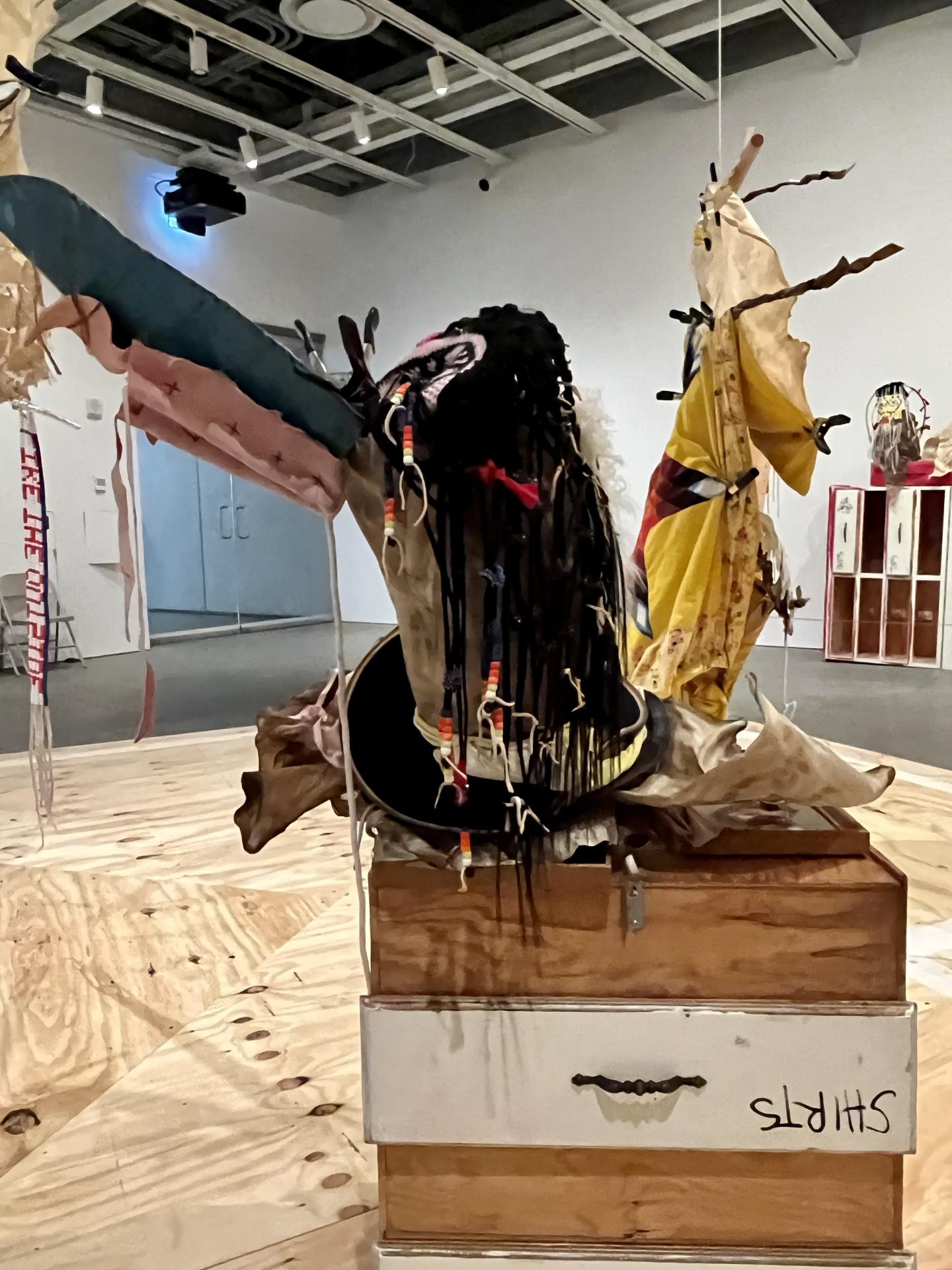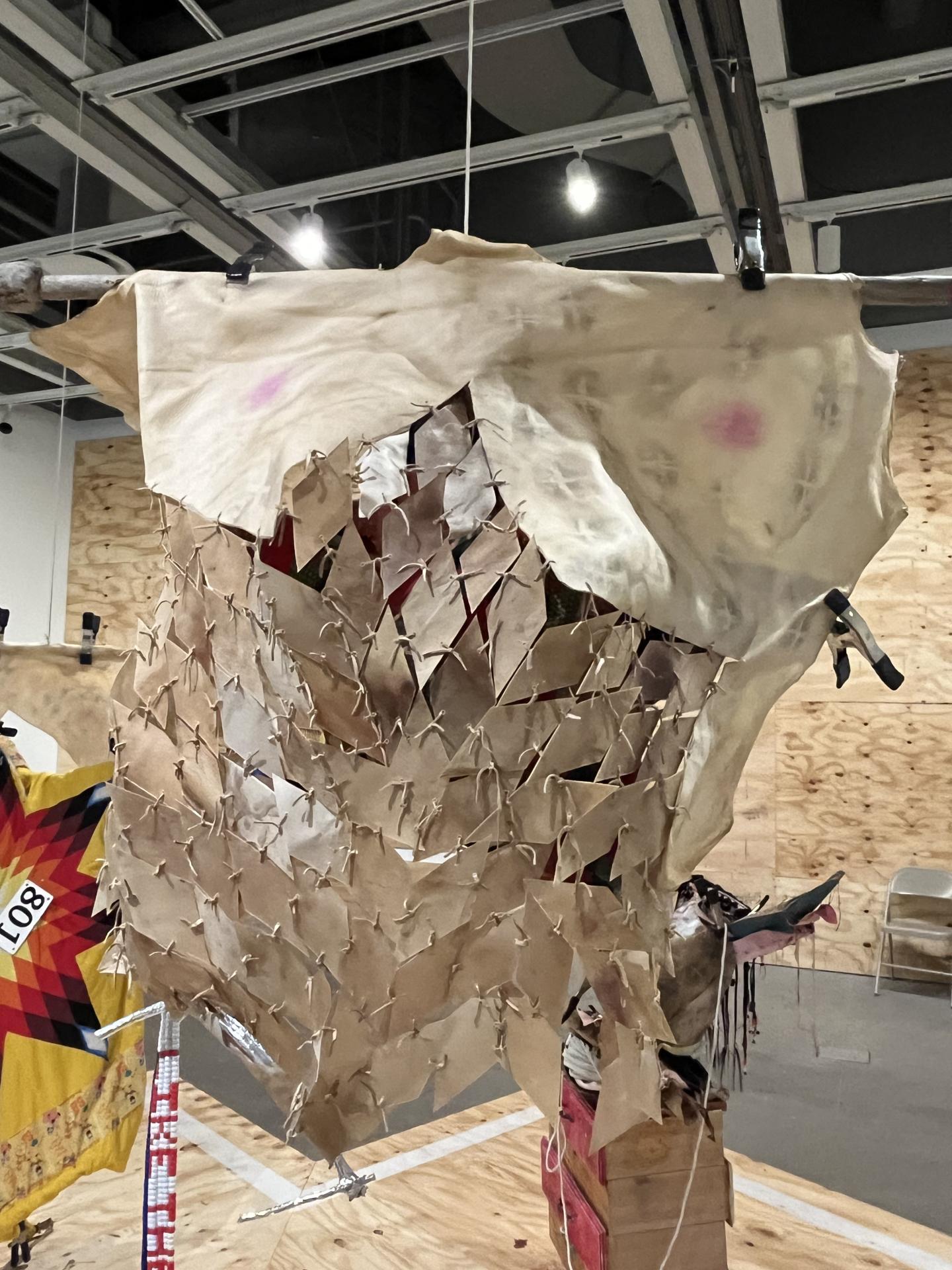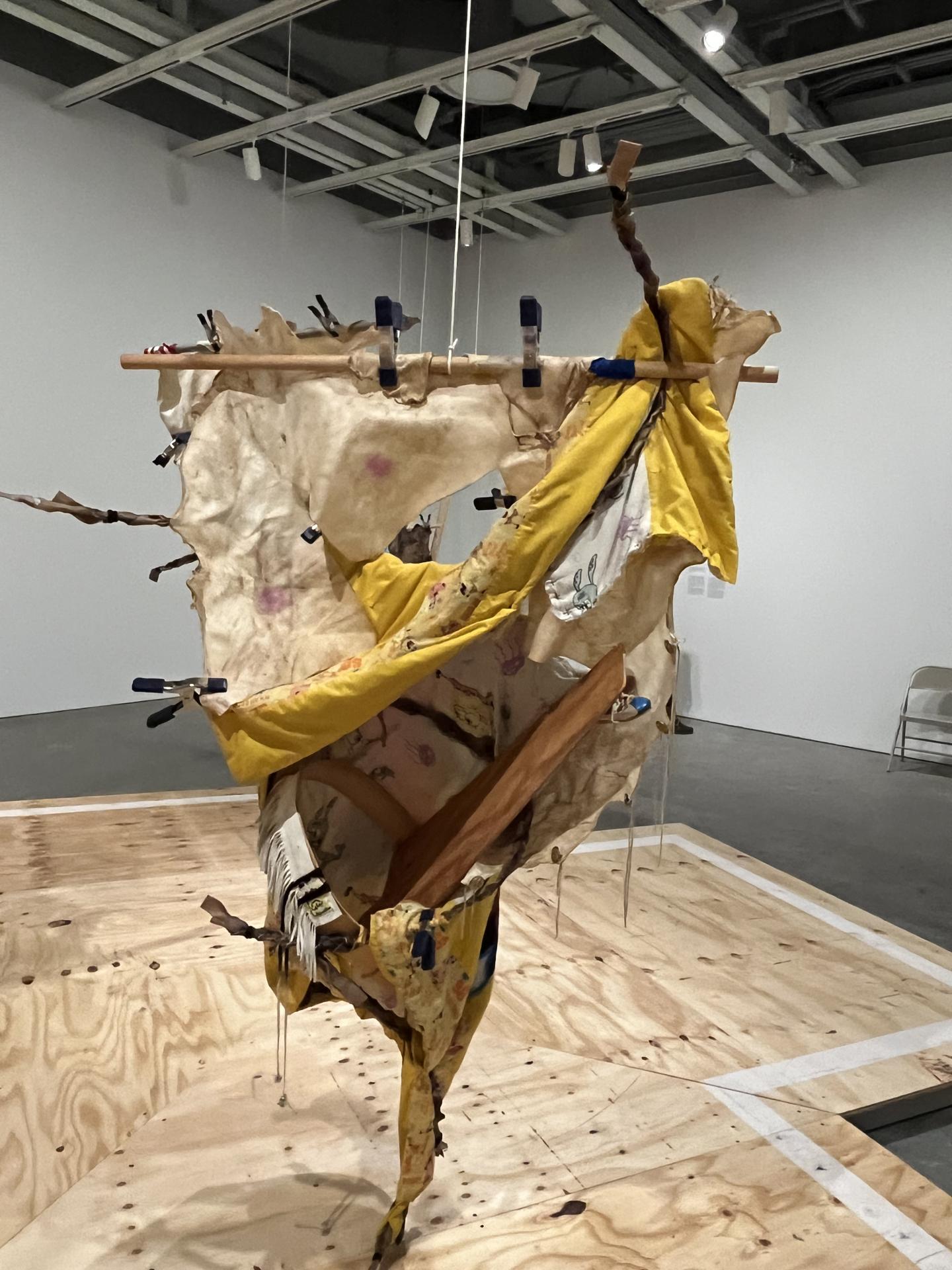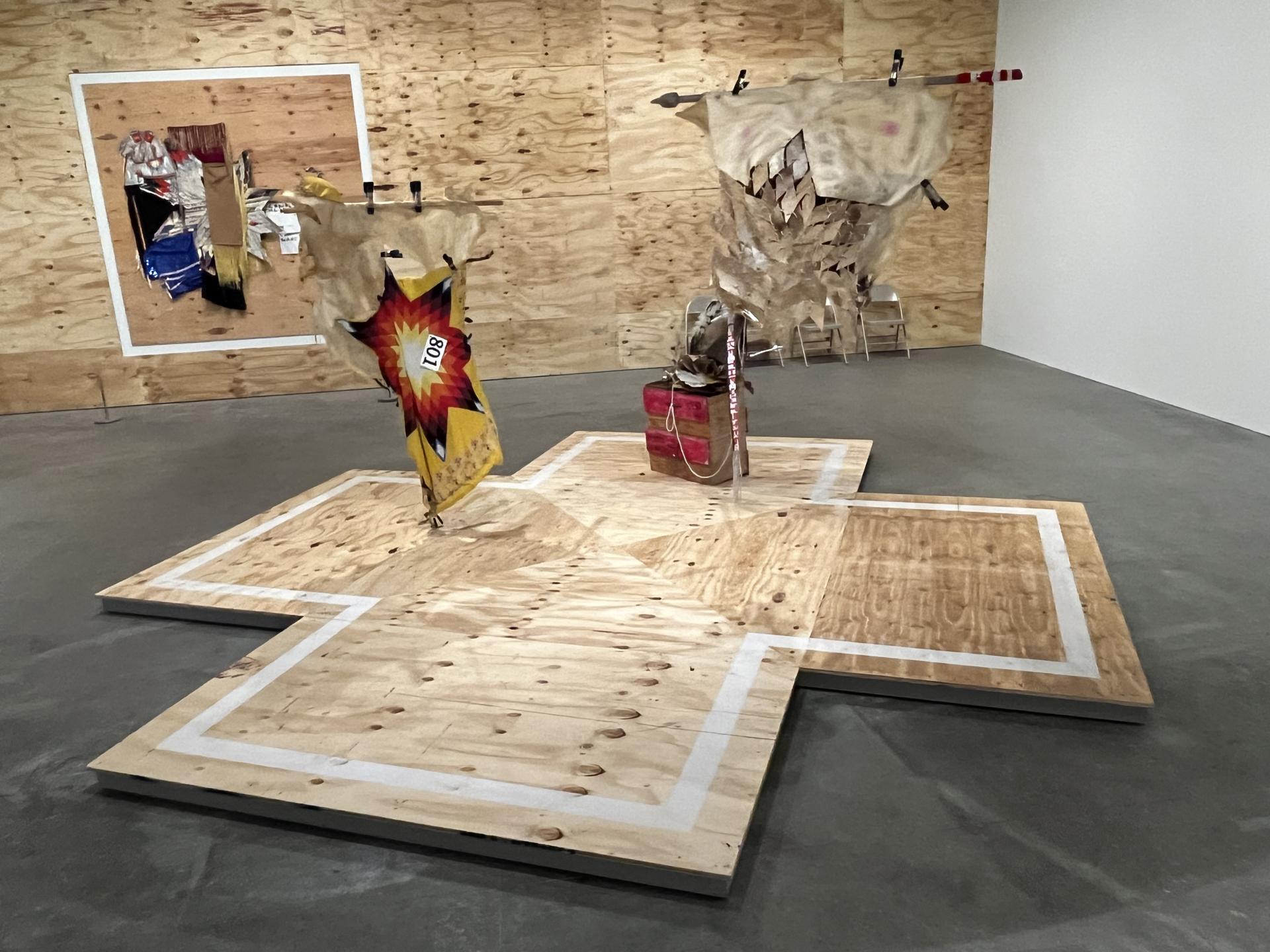
By Phoebe Farris (POWHATAN-PAMUNKEY)
From November 17, 2023, to February 19, 2024, the Whitney Museum of American Art in New York City featured a solo exhibition by interdisciplinary artist Natalie Ball (Modoc/ Klamath). Ball’s exhibit, titled “bilwi naats Ga’niipci,” translates in maqlaqsyals (the traditional language of the Klamath and Modoc Peoples) to “we smell like the outside,” a saying the artist associates with childhood family memories of Indigenous and Black cultural spaces. The word “naats,” translated as “we,” references her multiple identities as a Klamath, Modoc, and Black artist. Ball is based in Chiloquin, Oregon, on her ancestral homelands in what is now southern Oregon and Northern California. She is also a newly elected official of the Klamath Tribe’s Tribal Council and a proud mother of three. She credits her children with inspiring her to get into politics to ensure a good future for them.

Ribbon skirt There’s Indian and then there’s Indian., 2023. Wood, elk rawhide, satin ribbon metal, artificial hair, plastic beads, glass beads, shell, aluminum foil, pencil erasers, cotton, satin, rayon, metal clamps, rope, makeup, and graphite.
Ball’s creative process involves gathering a variety of materials such as hides, quilts, newspaper, and plywood, which she shapes and stitches together into layered sculp-tural assemblages. She has previously stated that the materials she uses “bring with them their histories and hopes for the future,” and calls it “a privilege to have a relationship to materials in this way.” Her studio spaces include her home, garage, yard, and the ya-ah-gah goo’ geh (Williamson River).
Born in Portland, Oregon, in 1980, Ball is enrolled in the Klamath Tribes and also of Modoc, Anglo-American, and African-American descent. She is a proud descendant of Kientpaush, a.k.a. Captain Jack (1837-1873), the chief who led the Modoc to fight the U.S. in the 1872 Modoc War. Her painter grandfather and quiltmaker aunt inspired her creativity. Her family moved from Klamath land to Portland, Oregon, after the 1954 Klamath Termination Act, when Klamath Tribes were terminated from federal recognition by an act of the United States Congress. In 1986, the Klamath Tribes regained federal recognition.
Ball earned a bachelor’s degree in Art and Ethnic Studies from the University of Oregon, a master’s degree in Māori Visual Arts from Massey University in Palmerston North, New Zealand, and a Masters in Fine Arts from Yale University School of Art in 2018. Installation art, performance art, mixed- media, sculpture, painting, and printmaking are among her artforms. In addition to her Whitney exhibition, Ball’s work has been shown in Hungary, New Zealand, the Seattle Art Museum, the Portland Art Museum, and the IAIA Museum of Contemporary Native Arts in Santa Fe. She has received numerous awards and fellowships, including Native Arts and Cultures Foundation’s Oregon Native Arts Fellowship (2021), the Ford Family Foundation’s Hallie Ford Foundation Fellow (2020), the Joan Mitchell Painters & Sculptors Grant (2020), Pollock-Krasner Foundation Grant (2019), and the Seattle Art Museum’s Betty Bowen Award (2018).
 with a hat to match!, 2023. Elk rawhide, wood, cotton, satin, artificial hair, sheep hair, framed poster, metal, tattoo ink, pastel, makeup, oil, leather, metal clamps, yarn, plastic beads, glass beads, felt, plastic, rope, and graphite.
with a hat to match!, 2023. Elk rawhide, wood, cotton, satin, artificial hair, sheep hair, framed poster, metal, tattoo ink, pastel, makeup, oil, leather, metal clamps, yarn, plastic beads, glass beads, felt, plastic, rope, and graphite.
Many of Ball’s sculptures, like her 2023 piece, “ribbon skirt There’s Indian and then there’s Indian,” deal with the body and concepts associated with belonging. Constructed of wood, elk, rawhide, satin, ribbons, metal, artificial hair, plastic and glass beads, shell, aluminum foil, metal clamps, and graphite, a rope attached to the ceiling suspends vertical poles that connect to the rest of the sculpture that is anchored on the floor.

Burden Basket, 2023. Elk rawhide, cotton, newspaper, wood, leather, plastic beads, willow branches, artificial hair, aluminum foil, chalk, metal clamps, rope, makeup, and graphite.
For Ball, as for many Indigenous people, belonging is often questioned, and its meaning changes in varying spaces. Her curator’s statement at the Whitney reads, “She strives at once to channel those who lived before her, reflect on her own experiences, and hold close the awareness that she is also a future ancestor with responsibilities to generations yet to come.”
About the role of auto-ethnography in her artistic process and how it helps reshape the narrative around Indigenous identities, Ball says, "Auto-ethnography shows up in my work through specific narratives that drive the materials to create the figurative sculptures through assemblage. I also love being generous in my lectures by showing the images from my visual archive that are driving the materiality and auto-ethnographic swag of my practice." About the selection process of historical and personal landscapes in her work Ball shares, "My connection to place, communities both urban and rural, and my family and personal experiences shape the work. For example, my work around blood politics and using Deer Woman as an avatar for myself."
The history of violence, dispossession, and survival are central themes in Ball's work. She elaborates on how these elements influence her choice of subjects and the stories to tell through her art, "It starts with that, most of the time because it's woven into these histories that I am mapping, but so is joy and existence as resistance as a celebration. My artwork comes from a studio space of cultivated joy as well. That is as important as knowing the history of violence, dispossession, and survival."
Disrupting mainstream definitions of "Indian" is a powerful objective. When asked about how Ball measures the impact of her work in this regard, she answers, "I am just holding this space for other artists to come along who will also challenge how we see 'Indian' and complicate that static idea to show more dimension and complexity. I am letting these institutions know that we are coming and that we’ve been here. Just showing up in spaces bringing all of who I am is important, representation is important. I had to fight for that. I just see myself as a future ancestor, and I make work as such, so I may never see results while I’m here. I just believe in the work that I’m doing, if it’s for no one but my kids, then that’s the work."

Baby Board, 2023. Cotton, elk rawhide, wood, synthetic fabric, leather, artificial hair, safety pins, metal clamps, glass beads, plastic beads, metal, shells, rope, makeup, and graphite.
In her artist statement for the National Gallery of Art, Ball expounds, “Through auto-ethnography, I attempt to move ‘Indian’ outside of governing discourses to offer a visual genealogy that refuses to line up with the many constructed existences of Native Americans. I map personal and historical landscapes, allowing them to travel through generations, engaging the history of violence, dispossession, and survivance while filling in gaps and forging stories to hold space for new complex narratives to exist. To disrupt mainstream definitions of Indian with personal, community, and U.S. histories that reflect the complexity of Native American lives, like my own, is to better understand ourselves, the nation, and necessarily our shared experiences and histories.”
Phoebe Mills Farris, Ph.D. (Powhatan-Pamunkey) is a Purdue University Professor Emerita, photographer, and freelance art critic.

Learn more about Natalie Ball’s work: www.natalieball.com.
